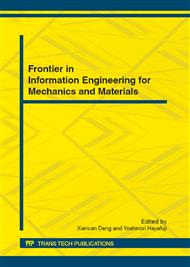[1]
ZHOU Jian-bin. Study on the mechanism of action and in environmental protection[D]. Dissertatin for Ph. D of Nanjing Forestry University, (2005).
Google Scholar
[2]
ZHANG Qi-sheng, ZHOU Jian-bin. Outstanding Functions of Bamboo Charcoal[J]. China forest products industry, 2007, 34(1): 3-8.
Google Scholar
[3]
ZHANG Wen-biao, LI Wen-zhu, ZENG Fang-di. Infrared radiation with bamboo charcoal[J]. Journal of Zhejiang Forestry College, 2008,25(5):573-577.
Google Scholar
[4]
KANG Fei-yu. Research Actvities of Japan in Carbon Materlals [J]. New Carbon Materials, 1998, 13(1): 75-78.
Google Scholar
[5]
CHIYUYONGYUAN. The efficiency of bamboo charcoal[D]. Japan: publish house of ZHIHE, 1999, 1~100.
Google Scholar
[6]
Isamu IDE, Shigehisa ISHIHARA. Carbon-Based Composites from Bamboo Charcoal and Its Applications[J]. Journal of the society of materials science, 1994, 43(485): 152~157.
Google Scholar
[7]
ZHANG Wen-biao. Production and application of bamboo charcoal and vinegar[M]. Beijing: China Forestry Publishing House, (2006).
Google Scholar
[8]
ZHANGW Wen-biao, QIAN Xin-biao, MA Ling-fei. Adsorption properties of bamboo charcoal under different carbonized temperatures for heavy metal ions[J]. Journal of Nanjing Forestry University(Natural Sciences Edition), 2009,36(3):20-24.
Google Scholar
[9]
ZHU Tie-quan, WANG Chang-sui, XU Da-li, et al. Preliminarily exploration to the carbonization technique of the black pottery in Shuangdun site[J]. Sciences of Conservation and Archaeology,2005,17(2):1-8.
Google Scholar
[10]
ZHANG Wen-biao, LI Wen-zhu, ZHANG Wei-gang. Preparation and structural characterization of bamboo charcoal pottery composites[J]. Scientia silvae sinicae, 2011, 47(3): 140-145.
Google Scholar
[11]
ZHANG Jian, CHEN Zhi-lin, ZHOU Jian-bin, et al. The Microstructure and Spectral Analysis of SiC Ceramics from Bamboo Charcoal[J]. Journal of Materials Engineering, 2009, 254-257.
Google Scholar
[12]
JIANG Zeihui, REN Hai-qin, FEI Ben-hua, et al. The micro-structure and properties of charcoal and SiC ceramics derived from bamboo[J]. New Carbon Materials, 2006, 21 (1): 1-8.
Google Scholar
[13]
LI Yan, XIA Jin-tong, SHAO Hao-ming. Study on Electric Heating Property of Carbon/Ceramic Composites[J]. Journal of Aeronautical Materials, 2006, 26(2):57-61.
Google Scholar
[14]
TU Jian-hua, ZHANG Li-bo, PENG Jin-hui, et al. Structure Evolution of Woodceramics by X-ray Diffraction and Raman Spectroscopy[J]. Journal of Inorganic Materials,2006,21(4):986-992.
Google Scholar
[15]
F. Tuistra, J.L. Koeing. Characterization of Graphite Fiber Surfaces with Raman Spectroscopy[J]. J . Composite Materials, 1970, 4: 492~499.
Google Scholar
[16]
Yang Xu Gang, Wu Qi Lin. Raman spectrum analysis and application[M]. Beijing: National Defence Industry Press, (2008).
Google Scholar
[17]
Cheng Hui-ming, Endo H, Okabe T, et al. Journal of Porous Materials, 1999, 6: 233-237.
Google Scholar
[18]
Sadezky A, Muckenhuber H, Grothe H, et al. Carbon, 2005, 43: 1731-1742.
Google Scholar
[19]
Sze S K, siddique N, Sloan J J, et al. Atmospheric Environment, 2001, 35: 561-568.
Google Scholar
[20]
Escribano R, Sloan J J, siddique N, et al. Vibrational Spectroscopy, 2001, 26: 179-186.
Google Scholar
[21]
Jawhari T, Roid A, Casado J. carbon, 1995, 33(11): 1561-1565.
DOI: 10.1016/0008-6223(95)00117-v
Google Scholar
[22]
Tuinstra F, Koenig J L. Raman spectrum of graphite[J]. The Journal of Chemical Physics, 1970, 53( 3): 1126-1130.
DOI: 10.1063/1.1674108
Google Scholar
[23]
FENG You-li, ZHENG Zhe, GUO Yan jun. Researching on the charact eristics of microstructures of carbonated tree[J]. Acta Scientiarum Naturalium Universit atis Pekinensis, 2003, 39(5): 727-731.
Google Scholar


